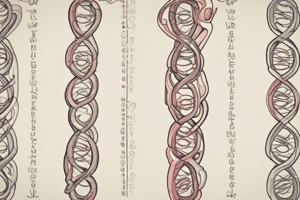Podcast
Questions and Answers
What sequence of events does DSD refer to in relation to puberty?
What sequence of events does DSD refer to in relation to puberty?
DSD refers to disorders where the normal sequence of puberty events does not occur.
What is the chromosomal composition associated with Turner syndrome?
What is the chromosomal composition associated with Turner syndrome?
Turner syndrome is characterized by a total of 45 chromosomes, typically noted as 45XO due to the absence of one X chromosome.
List two typical clinical features of Turner syndrome.
List two typical clinical features of Turner syndrome.
Short stature and webbing of the neck are two typical features of Turner syndrome.
How does the ovarian development in Turner syndrome typically present at birth?
How does the ovarian development in Turner syndrome typically present at birth?
When is the diagnosis of Turner syndrome often made in females?
When is the diagnosis of Turner syndrome often made in females?
What psychological considerations are mentioned for girls with Turner syndrome?
What psychological considerations are mentioned for girls with Turner syndrome?
What is indicated by the term '46XY gonadal dysgenesis'?
What is indicated by the term '46XY gonadal dysgenesis'?
What are the primary focuses of treatment for childhood and adolescence in Turner syndrome?
What are the primary focuses of treatment for childhood and adolescence in Turner syndrome?
What genetic mutation is often associated with complete gonadal dysgenesis, specifically Swyer syndrome?
What genetic mutation is often associated with complete gonadal dysgenesis, specifically Swyer syndrome?
What hormone's absence leads to the normal development of Müllerian structures in Swyer syndrome?
What hormone's absence leads to the normal development of Müllerian structures in Swyer syndrome?
Describe the typical presentation of a patient with complete gonadal dysgenesis at adolescence.
Describe the typical presentation of a patient with complete gonadal dysgenesis at adolescence.
What is the primary risk associated with the dysgenetic gonad in individuals with Swyer syndrome?
What is the primary risk associated with the dysgenetic gonad in individuals with Swyer syndrome?
In mixed gonadal dysgenesis, what type of karyotype may be present aside from the commonly noted 46XX?
In mixed gonadal dysgenesis, what type of karyotype may be present aside from the commonly noted 46XX?
What is the most common cause of 46XY DSD, particularly in relation to androgen receptor function?
What is the most common cause of 46XY DSD, particularly in relation to androgen receptor function?
What anatomical characteristics are typical in a baby born with complete androgen insensitivity syndrome?
What anatomical characteristics are typical in a baby born with complete androgen insensitivity syndrome?
How does the presence of testicular tissue affect the anatomy in cases of mixed gonadal dysgenesis?
How does the presence of testicular tissue affect the anatomy in cases of mixed gonadal dysgenesis?
What is the typical initial management approach for a patient diagnosed with primary amenorrhea related to XY karyotype?
What is the typical initial management approach for a patient diagnosed with primary amenorrhea related to XY karyotype?
Why is gonadectomy recommended for individuals with an XY karyotype?
Why is gonadectomy recommended for individuals with an XY karyotype?
What procedure is most effective for improving vaginal length in patients with a shortened vagina?
What procedure is most effective for improving vaginal length in patients with a shortened vagina?
What is the primary cause of 46XX DSD and how does it affect fetal development?
What is the primary cause of 46XX DSD and how does it affect fetal development?
What distinctive presentation occurs in a child with 5-alpha-reductase deficiency at birth?
What distinctive presentation occurs in a child with 5-alpha-reductase deficiency at birth?
What are the effects of raised androgen levels in a female fetus with 21-hydroxylase CAH?
What are the effects of raised androgen levels in a female fetus with 21-hydroxylase CAH?
Explain the sexual assignment typically made for a child with 5-alpha-reductase deficiency in the Western world.
Explain the sexual assignment typically made for a child with 5-alpha-reductase deficiency in the Western world.
What complication is associated with the 'salt-losing' variety of 21-hydroxylase deficiency in CAH?
What complication is associated with the 'salt-losing' variety of 21-hydroxylase deficiency in CAH?
Flashcards are hidden until you start studying
Study Notes
Disorders of Sexual Development (DSD)
- DSDs involve a mismatch between an individual's chromosomal sex and their physical sexual characteristics.
- DSDs can be diagnosed at birth with ambiguous genitalia or may be discovered later during puberty due to issues like primary amenorrhea or virilization in girls.
Causes of DSD
- Turner Syndrome:
- Occurs in individuals with a 45XO karyotype, meaning a complete or partial absence of one X chromosome.
- Most common chromosomal anomaly in females, affecting approximately 1 in 2,500 births.
- Characterized by short stature, webbing of the neck, and a wide carrying angle.
- Associated medical conditions include heart defects, digestive issues, hearing loss, kidney problems, and thyroid dysfunction.
- Ovaries are underdeveloped (streak gonads) and do not produce estrogen or eggs.
- Diagnosis usually occurs at birth or in early childhood, sometimes during adolescence with delayed puberty.
- Management focus is on growth in childhood and puberty induction later.
- Pregnancy is possible through ovum donation.
- Psychological support is crucial for individuals with this condition.
- 46XY Gonadal Dysgenesis:
- Individuals have an XY karyotype but their gonads do not develop into testes.
- In approximately 15% of cases, a mutation in the SRY gene on the Y chromosome is responsible.
- In complete gonadal dysgenesis (Swyer syndrome), the gonads are streak gonads and do not produce hormones.
- The Müllerian structures develop normally due to no AMH production.
- Since testosterone is not produced, external genitalia are female-appearing.
- Presented at adolescence due to delayed puberty.
- Due to high malignancy risk, gonads are surgically removed after diagnosis.
- Puberty is induced with estrogen.
- Pregnancy is possible with donor oocytes.
- Psychological support is vital.
- Mixed Gonadal Dysgenesis:
- More complex condition involving both functioning ovarian and testicular tissue.
- Karyotype can be 46XX, but XX/XY mosaicism is present in 20% of cases.
- Anatomical findings vary depending on gonad function.
- If testes are functional, virilization and ambiguous or male genitalia may occur.
- Müllerian structures may be absent on the side of the functioning testis, but a unicornuate uterus may be present.
46XY Disorders of Sexual Development (DSD)
- Complete Androgen Insensitivity Syndrome (CAIS):
- Occurs in individuals where the androgen receptor does not respond to androgen stimulation, leading to a lack of virilization.
- Normal testes develop due to the SRY gene, leading to AMH production and regression of Müllerian ducts.
- Testosterone is produced but the lack of receptor response prevents external genitalia from virilizing.
- Individuals are born with normal female external genitalia, an absent uterus, and testes located in the abdominal cavity or inguinal canal.
- Presented at puberty with primary amenorrhea.
- Management involves psychological support, full disclosure of the XY karyotype and infertility, gonadectomy to reduce the risk of testicular cancer, and long-term hormone replacement therapy (HRT).
- Shortened vaginal length may require dilation or reconstructive surgery.
- Partial androgen insensitivity leads to limited virilization with ambiguous genitalia.
- 5-Alpha-Reductase Deficiency:
- Individuals with this condition have an XY karyotype and normal functioning testes that produce testosterone and AMH.
- However, the inability to convert testosterone to dihydrotestosterone prevents proper male development.
- Presentation often includes ambiguous genitalia at birth or increasing virilization at puberty in a female-assigned individual.
- Assignment to a female sex of rearing is typically done in Western settings.
46XX Disorders of Sexual Development (DSD)
- Congenital Adrenal Hyperplasia (CAH):
- Most common cause of 46XX DSD.
- Occurs due to enzyme deficiencies in the adrenal cortex, primarily a deficiency in 21-hydroxylase.
- This leads to an excess of androgen precursors and elevated testosterone production, causing virilization of the female fetus.
- Characterized by an enlarged clitoris, fused labia, and a common urogenital opening on the perineum.
- About two-thirds of individuals with 21-hydroxylase CAH have a ‘salt-losing’ variant impacting aldosterone production.
Studying That Suits You
Use AI to generate personalized quizzes and flashcards to suit your learning preferences.




